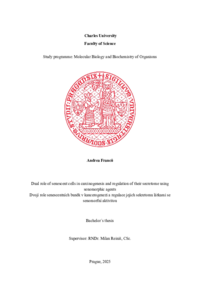Dual role of senescent cells in carcinogenesis and regulation of their secretome using senomorphic agents.
Dvojí role senescentních buněk v kancerogenezi a regulace jejich sekretomu látkami se senomorfní aktivitou.
bakalářská práce (OBHÁJENO)

Zobrazit/
Trvalý odkaz
http://hdl.handle.net/20.500.11956/199474Identifikátory
SIS: 279712
Kolekce
- Kvalifikační práce [20850]
Autor
Vedoucí práce
Oponent práce
Janoštiak, Radoslav
Fakulta / součást
Přírodovědecká fakulta
Obor
Molekulární biologie a biochemie organismů
Katedra / ústav / klinika
Katedra genetiky a mikrobiologie
Datum obhajoby
29. 5. 2025
Nakladatel
Univerzita Karlova, Přírodovědecká fakultaJazyk
Angličtina
Známka
Výborně
Klíčová slova (česky)
Buněčná senescence, kancerogeneze, sekretom, cytokiny, imunosuprese, senomorfní látkyKlíčová slova (anglicky)
Cellular senescence, carcinogenesis, secretome, cytokines, immunosuppression, senomorphic agentsBuněčná senescence je stresová odpověď buňky a představuje především ochranný mechanismus proti nádorové transformaci, avšak může také přispívat k růstu nádorů. Během senescence se aktivují signalizační dráhy, které regulují expresi a tvorbu se senescencí asociované sekrečního fenotypu (SASP). Komponenty sekretomu zprostředkovávají interakci s prostředím a ovlivňují imunitní systém. Některé protinádorové terapie vedou a využívají senescenci k inhibici růstu nádoru a k regulaci imunitní odpovědi. Zároveň však mohou způsobit senescenci v nenádorových buňkách, které také mohou podpořit růst nádorů a potlačit imunitní odpověď. Pokud nedojde k odstranění senescentních buněk nebo jejich vlivů, přetrvávající účinky sekretomu vedou k chronickému zánětu, podporují invazi do okolní tkáně a přispívají k progresi nádoru po remisi. Cílené odstranění senescentních buněk nebo modulace sekretomu představuje v posledních letech možné řešení pro potlačení vedlejších účinků protinádorových terapií. Senomorfika jsou látky, které cílí na fenotyp senescentních buněk a které většinou inhibují signalizační dráhy regulující sekretom bez toho, aniž by ovlivnily životaschopnost buněk (na rozdíl od senolytik). Dlouhodobé potlačení účinků sekretomu pomocí senomorfních agents by mohlo v budoucnu odvrátit negativní dopad...
Cellular senescence is a stress response that primarily serves as a protective mechanism against tumor transformation. However, it can also contribute to tumor growth. During senescence, signaling pathways that regulate the expression and production of senescence-associated secretory phenotype (SASP) are activated. Components of the secretome mediate interactions with the microenvironment and influence the immune system. Anticancer therapies induce and utilize senescence to inhibit tumor growth and regulate the immune response. Such therapies can also induce senescence in non-cancerous cells, which may support tumor growth and suppress the immune response. If senescent cells or their effects are not eliminated, the persistent presence of the secretome leads to chronic inflammation, promotes invasiveness and cancer relapse. Targeted removal of senescent cells or modulation of their secretome has emerged as a potential solution to alleviate the side effects of anticancer therapies. Senomorphic agents target the phenotype of senescent cells and typically inhibit the signaling pathways that regulate the secretome without affecting cell viability (unlike senolytics). Long-term modulation of secretome activity using senomorphic agents could help overcome the negative impact of senescent cells on the...
